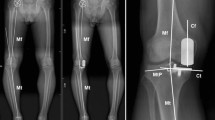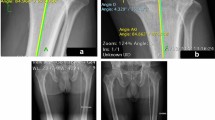Abstract
Purpose
The purpose of this study was to identify risk factors of post-operative malalignment in medial unicompartmental knee arthroplasty (UKA) using multivariate logistic regression.
Methods
We retrospectively enrolled 92 patients who had 127 medial UKAs. According to post-operative limb mechanical axis (hip-knee-ankle [HKA] angle), 127 enrolled knees were sorted into acceptable alignment with HKA angle within the conventional ± 3 degree range from a neutral alignment (n = 73) and outlier with HKA angle outside ± 3 degree range (n = 54) groups. Multivariate logistic regression was used to analyse risk factors including age, gender, body mass index, thickness of polyethylene tibial insert, pre-operative HKA angle, distal femoral varus angle (DFVA), femoral bowing angle (FBA), tibial bone varus angle (TBVA), mechanical distal femoral and proximal tibial angles, varus and valgus stress angles, size of femoral and tibial osteophytes, and femoral and tibial component alignment angles.
Results
Pre-operative DFVA, TBVA and valgus stress angle were identified as significant risk factors. As DFVA increased by one degree, malalignment was about 45 times probable (adjusted OR 44.871, 95 % CI 2.608–771.904). Shift of TBVA and valgus stress angle to a more varus direction were also significant risk factors (adjusted OR 13.001, 95 % CI 1.754–96.376 and adjusted OR 2.669, 95 % CI 1.054–6.760).
Conclusions
Attention should be given to the possibility of post-operative malalignment during medial UKA in patients with a greater varus angle in pre-operative DFVA, TBVA and valgus stress angle, especially with a greater varus DFVA, which was the strongest predictor for malalignment.




Similar content being viewed by others
References
Burnett RS, Nair R, Hall CA, Jacks DA, Pugh L, McAllister MM (2014) Results of the Oxford Phase 3 mobile bearing medial unicompartmental knee arthroplasty from an independent center: 467 knees at a mean 6-year follow-up: analysis of predictors of failure. J Arthroplasty 29(9):193–200
Barbadoro P, Ensini A, Leardini A, d’Amato M, Feliciangeli A, Timoncini A, Amadei F, Belvedere C, Giannini S (2014) Tibial component alignment and risk of loosening in unicompartmental knee arthroplasty: a radiographic and radiostereometric study. Knee Surg Sports Traumatol Arthrosc 22(12):3157–3162
Kim KT, Lee S, Kim TW, Lee JS, Boo KH (2012) The influence of postoperative tibiofemoral alignment on the clinical results of unicompartmental knee arthroplasty. Knee Surg Relat Res 24(2):85–90
Collier MB, Engh CA Jr, McAuley JP, Engh GA (2007) Factors associated with the loss of thickness of polyethylene tibial bearings after knee arthroplasty. J Bone Joint Surg Am 89(6):1306–1314
Kasodekar VB, Yeo SJ, Othman S (2006) Clinical outcome of unicompartmental knee arthroplasty and influence of alignment on prosthesis survival rate. Singap Med J 47(9):796–802
Ridgeway SR, McAuley JP, Ammeen DJ, Engh GA (2002) The effect of alignment of the knee on the outcome of unicompartmental knee replacement. J Bone Joint Surg (Br) 84(3):351–355
Gulati A, Chau R, Simpson DJ, Dodd CA, Gill HS, Murray DW (2009) Influence of component alignment on outcome for unicompartmental knee replacement. Knee 16(3):196–199
Vasso M, Del Regno C, D’Amelio A, Viggiano D, Corona K, Schiavone Panni A (2015) Minor varus alignment provides better results than neutral alignment in medial UKA. Knee 22(2):117–121
Gulati A, Pandit H, Jenkins C, Chau R, Dodd CA, Murray DW (2009) The effect of leg alignment on the outcome of unicompartmental knee replacement. J Bone Joint Surg (Br) 91(4):469–474
Kim SJ, Bae JH, Lim HC (2012) Factors affecting the postoperative limb alignment and clinical outcome after Oxford unicompartmental knee arthroplasty. J Arthroplasty 27(6):1210–1215
Mullaji AB, Shetty GM, Kanna R (2011) Postoperative limb alignment and its determinants after minimally invasive Oxford medial unicompartmental knee arthroplasty. J Arthroplasty 26(6):919–925
John J, Kuiper JH, May PC (2009) Age at follow-up and mechanical axis are good predictors of function after unicompartmental knee arthroplasty. An analysis of patients over 17 years follow-up. Acta Orthop Belg 75(1):45–50
Leitch KM, Birmingham TB, Dunning CE, Giffin JR (2013) Changes in valgus and varus alignment neutralize aberrant frontal plane knee moments in patients with unicompartmental knee osteoarthritis. J Biomech 46(7):1408–1412
Eckstein F, Wirth W, Hudelmaier M, Stein V, Lengfelder V, Cahue S, Marshall M, Prasad P, Sharma L (2008) Patterns of femorotibial cartilage loss in knees with neutral, varus, and valgus alignment. Arthritis Rheum 59(11):1563–1570
Kim JM, Hong SH, Kim JM, Lee BS, Kim DE, Kim KA, Bin SI (2015) Femoral shaft bowing in the coronal plane has more significant effect on the coronal alignment of TKA than proximal or distal variations of femoral shape. Knee Surg Sports Traumatol Arthrosc 23(7):1936–1942
van Raaij TM, Takacs I, Reijman M, Verhaar JA (2009) Varus inclination of the proximal tibia or the distal femur does not influence high tibial osteotomy outcome. Knee Surg Sports Traumatol Arthrosc 17(4):390–395
Moon YW, Kim JG, Han JH, Do KH, Seo JG, Lim HC (2013) Factors correlated with the reducibility of varus deformity in knee osteoarthritis: an analysis using navigation guided TKA. Clin Orthop Surg 5(1):36–43
Kreitz TM, Maltenfort MG, Lonner JH (2015) The valgus stress radiograph does not determine the full extent of correction of deformity prior to medial unicompartmental knee arthroplasty. J Arthroplasty 30(7):1233–1236
Tashiro Y, Matsuda S, Okazaki K, Mizu-Uchi H, Kuwashima U, Iwamoto Y (2014) The coronal alignment after medial unicompartmental knee arthroplasty can be predicted: usefulness of full-length valgus stress radiography for evaluating correctability. Knee Surg Sports Traumatol Arthrosc 22(12):3142–3149
Waldstein W, Bou Monsef J, Buckup J, Boettner F (2013) The value of valgus stress radiographs in the workup for medial unicompartmental arthritis. Clin Orthop Relat Res 471(12):3998–4003
Hopgood P, Martin CP, Rae PJ (2004) The effect of tibial implant size on post-operative alignment following medial unicompartmental knee replacement. Knee 11(5):385–388
Falez F (2014) Knee arthroplasty today. Int Orthop 38(2):221–225
Emerson RH Jr, Hansborough T, Reitman RD, Rosenfeldt W, Higgins LL (2002) Comparison of a mobile with a fixed-bearing unicompartmental knee implant. Clin Orthop Relat Res 404:62–70
Emerson RH Jr, Head WC, Peters PC Jr (1992) Soft-tissue balance and alignment in medial unicompartmental knee arthroplasty. J Bone Joint Surg (Br) 74(6):807–810
Citak M, Dersch K, Kamath AF, Haasper C, Gehrke T, Kendoff D (2014) Common causes of failed unicompartmental knee arthroplasty: a single-centre analysis of four hundred and seventy one cases. Int Orthop 38(5):961–965
Vasso M, Del Regno C, Perisano C, D’Amelio A, Corona K, Schiavone Panni A (2015) Unicompartmental knee arthroplasty is effective: ten year results. Int Orthop. Jul 2 [Epub ahead of print]
Seng CS, Ho DC, Chong HC, Chia SL, Chin PL, Lo NN, Yeo SJ (2014) Outcomes and survivorship of unicondylar knee arthroplasty in patients with severe deformity. Knee Surg Sports Traumatol Arthrosc. 2014 Dec 3 [Epub ahead of print]
Nam D, Khamaisy S, Gladnick BP, Paul S, Pearle AD (2013) Is tibiofemoral subluxation correctable in unicompartmental knee arthroplasty? J Arthroplasty 28(9):1575–1579
Acknowledgments
This study was not supported by any foundation.
Conflict of interest
The authors declare that they have no conflict of interest.
Author information
Authors and Affiliations
Corresponding author
Rights and permissions
About this article
Cite this article
Ahn, J.H., Kang, H.W., Yang, T.Y. et al. Risk factors of post-operative malalignment in fixed-bearing medial unicompartmental knee arthroplasty. International Orthopaedics (SICOT) 40, 1455–1463 (2016). https://doi.org/10.1007/s00264-015-3014-1
Received:
Accepted:
Published:
Issue Date:
DOI: https://doi.org/10.1007/s00264-015-3014-1




